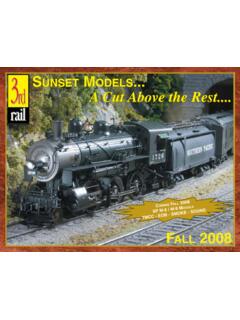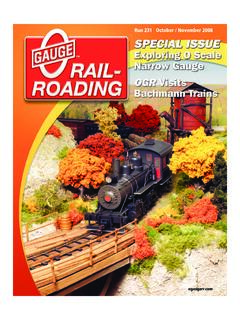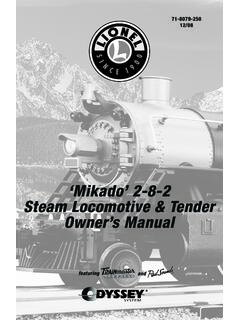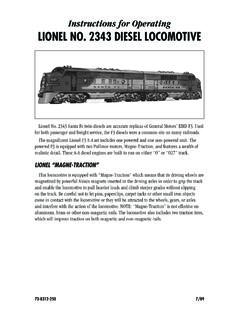Transcription of 3rd Rail N&W Streamlined K2a
1 31O GAUGE RAILROADING OCTOBER / NOVEMBER 2011At a first glance, the streamlinedNorfolk and Western 4-8-2 Classes K2 andK2a looked like the road s famed Class J 4-8-4. Because of their close resemblanceto the Js, the Streamlined K2 classes werefrequently referred to as J-Juniors. Beforethe onslaught of diesel locomotives, these4-8-2s were the regular power for themainline passenger runs on several of theN&W s divisions and they also pulledmainline locals. At the road s larger termi-nals, the K2 classes were standby power fortrains normally powered by the Js. In theirlater years of service, the versatile 4-8-2spulled mixed trains, local freights, andeven served on coal drags when the N&Wexperienced shortages of motive N&W first began using the 4-8-2mountain type for heavyweight passengerservice with 16 Class K1 locomotiveserected in the road s Roanoke Shops in1916 and 1917. They became the N&W sprimary power for mainline passengertrains, replacing 4-6-2s as the trainsbecame longer and a class, the K1 was so successful thatin 1919 the N&W accepted 10 USRA heavy4-8-2s built by Alco.
2 The road assigned theclass of K2 to these Alco 4-8-2s and num-bered them 116 125. Later the N&Wordered 12 additional 4-8-2s fromBaldwin based on the same USRA designas the Class K2. Erected in 1923, the 12 Baldwin 4-8-2s became N&W Class K2anumbered 126 137. Both K2 classes werenearly the same, but with a few subtle dif-ferences such as placement of the doublecheck valves and the bell on top of theboiler. On the K2, these valves were behindthe sand box, while on the K2a the valveswere in front. Both K2 classes rode on 69 drivers and developed 58,000 lbs of trac-tive effort from a boiler pressure of 200 all intents, the N&W considered theK2 and K2a as one of the distinctive characteristics ofthe N&W K2 classes was the location ofthe feedwater heater hanging from the leftside of the boiler between the second andthird drivers. When the engines werestreamlined in 1945 and 1946, a largeshroud extended down from the side skirt-ing to cover the feedwater part of their streamlining, the K2classes received larger tenders with a capac-ity of 30 tons of coal and 22,000 gallons ofwater.
3 Although these tenders looked likethe Class J s welded units, they were con-structed with rivets. Additionally, new 1/2 thicker tires increased driver diameter oneach J-Junior from the original 69 to 70 .The 1:48 scale 3rd Rail locomotive inthis review models K2a number 126 afterits second modernization in 1949. Roadnumbers 133 and 137 are also available. Inthe 1949 rework of the real J-Juniors, solidwheels replaced spoke wheels on the pilottrucks, and the tender trucks receivedroller bearings. However, each engine strailing truck retained its spoke bell was also relocated from on top ofthe boiler to the left side pilot beam behindthe steps. The resultant hole in the top ofthe boiler shroud was left thanks to Jimmy Lisle of theNorfolk & Western Historical Society for3rd Rail N&WStreamlined K2aReview and Photos by George Brown32O GAUGE RAILROADING OCTOBER / NOVEMBER 2011his help with prototype information aboutthe N&W 4-8-2s and specifically the and FeaturesSunset/3rd Rail is one of the fewbuilders today that produces brass steamlocomotives for the 3-rail O gauge hobby-ist.
4 Regardless of the type, each engine is alimited production model that is hand-crafted from brass sheets, wire, or bar stockalong with lost wax brass castings. Even thedrivers are made from brass using a processnot unlike the minting of axle for the drivers and tendertrucks is sprung, although the springs arerather stiff. To accommodate the inde-pendent vertical movement of each of thesprung drivers, the side rods are prototyp-ically articulated. Other operatingmechanical features include the prototypi-cal swing-out front coupler, mechanicaloiler linkage on the right side valve gear,opening vents on the cab roof, and open-ing water tank hatch. Underneath thishatch are the control switches for com-mand and sound LED headlight, green LED classifi-cation lights, and lit number boards adornthe front of the locomotive, while alight illuminates the inside of thecab. Inside the industrial green cabis a detailed boiler backhead withhand-painted valve handles andgauge faces.
5 The valves, gauges, andfirebox doors as well as the throttleand duplex stoker are all individualcastings. On each side of the cab, apainted figure representing a crew-man sits on its respective seat box. Adirectional backup light is on theback of the the back of the cab, a hingedstep plate fills the wide visible gapbetween the engine and , I found it rather curiousthat the only glazing in the cab wasin the window behind each crew-man. None of the other cab win-dows had clear plastic representingthe window glass of the real the boiler are a skew-wound Pittman motor equippedwith a large flywheel and a fan-dri-ven smoke unit. The unique silentdrive mechanism from 3rd Rail fea-tures a metal drive shaft that spins inball bearings, metal gears encased ina metal gearbox, and a toothed carbon-fiber drive belt that transfers mechanicalpower from the motor to the drive tender carries the TMCC andRailSounds electronics, licensed fromLionel, and the Cruise Commander motordriver board from Electric Railroad.
6 TheCruise Commander electronics use elec-tromotive feedback from the motor forspeed control rather than an external opti-cal sensor arrangement. Additionally, thisboard employs a high-frequency pulsewidth modulation of 20 MHz for quietmotor operation. Also inside the tender isa 9-volt battery for short-term backuppower to the sound system. A load of real coal fills the bunker inthe actually the load is a thinlayer of coal glued to a brass plate. Ofcourse, the paint and lettering onthe J-Junior are what I ve come toexpect from 3rd Rail flawless. Except for the extra length ofthe drawbar between the engine andtender, which is mandated by themodel s ability to run on O54 tin-plate curves, the model s majordimensions measured quite close orat 1:48 scale of the real streamlinedK2a. At TracksideStreamlined locomotives don tusually do much for me because thefascinating myriad of pipes, unions,and appliances associated withsteam are not visible.
7 But on therails and at the head of a passengeror freight train, I found the 3rd Railmodel of the K2a to be unusuallyhandsome and also well suited tomy rather small layout. Visually, theengine has a well-appreciated mass,but its modest length does notappear to overwhelm everythingelse on the tracks. A streamlined33O GAUGE RAILROADING OCTOBER / NOVEMBER 2011passenger train of 15 aluminum cars looked just as good asone with 20 cars, as did a freight train of steam-era boxcarsand the O72 loop of my editorial Carpet CentralRailroad, the J-Junior was at home at any speed from adead-slow crawl to an open throttle highball. It also negoti-ated the Atlas O72 crossovers between my O72 and O54main lines without hesitation in both forward and course, since the engine is designed for O54 minimumcurves, it also smoothly and dependably traveled my O54main line. Steam exhaust sounds are switch-selectable at two orfour chuffs per driver revolution, while another switchselects smoke unit voltage for either command or conven-tional operation or turns the unit off.
8 I opted for the realis-tic four chuffs, but with the smoke unit , the Lionel RailSounds generic heavysteam sound repertoire doesn t reproduce the hooter whis-tle of N&W fame, but the rest of the sounds are reasonableand are pleasantly loud, obviously to the annoyance of mynext door neighbor s dogs. With the sound system and dogsmuted, only the faint whir of the spinning motor and therush of the wheels on the rails broke the silence of my trainroom. Now that s what I call a quiet runner!The tender s coil-operated coupler opened on cue frommy CAB-1 remote controller every time, and what pleasedme the most was the light pressure necessary to close GAUGE RAILROADING OCTOBER / NOVEMBER 2011 Switching with the J-Junior wasrealistic and fun as it eased intothe awaiting baggage car orexpress enjoyed all of the J-Junior soperating effects using either myoriginal TMCC equipment orLionel s Legacy control Cruise Commander sdefault configuration for TMCC operation with a CAB-1 is 100speed steps with speed controlon.
9 To run the locomotive usingthe Legacy system with theCAB-2 in TMCC mode, youhave to configure the CruiseCommander for 32-step opera-tion as described in the locomo-tive s operations pamphlet. Oralternately, you can enjoy 100speed steps with the CAB-2 run-ning in CAB-1 mode, which wasmy the End of the RunBrass locomotives still havean aura that makes them uniquein today s world of die-caststeamers and plastic diesels. For the brass aficionado, the 3rd Rail model of theN&W Streamlined K2a beckons a closer look. I enjoyed my time with it. Norfolk and Western K2a 4-8-2 Retail price: $1, at 3rd Rail or 3rd Rail dealers800-373-7245; Rail N&W K2a Performance(smoke unit: off; sound: on; speed control: on)Length:25-1/2 over coupler; 25 pilot to tender sillDistance Between Pickup Rollers:1st and 2nd: 4-5/8 1st and 3rd: 13-1/8 1st and 4th: 17-1/4 Weight on Driving Wheels:7 lbs, 2 ozTender Weight:2 lbs, 8 ozTractive Effort @ 18 VAC:2 lbs, 7 oz @ A, 45 WMinimum Sustained Speed @ 18 VAC:2 scale mph @ A, WMaximum Tested Speed @ 18 VAC:60 scale mph @ A, 27 WTest TrainEight O scale aluminum Streamlined passenger cars;train weight 13 lbs; pull to move train 12 oz (ampsfor interior lights subtracted from all performancedata)35O GAUGE RAILROADING OCTOBER / NOVEMBER TRAINS, , CO 80030(888) 717-4196 Fax (303) 427-6805 The Wall Of Trains




